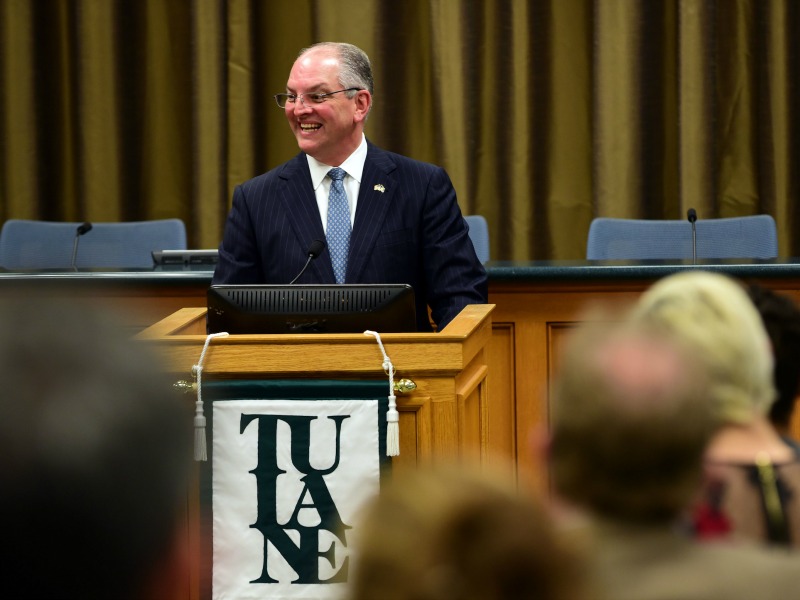Home / Gov. Edwards to speak a the Tulane Offshore Wind Conference Jan. 18
Gov. Edwards to speak a the Tulane Offshore Wind Conference Jan. 18
January 13, 2023 9:00 AM

Louisiana Gov. John Bel Edwards will address Tulane Law's inaugural offshore wind conference Wednesday as the state begins to tap into the potential of wind energy in the region.
Edwards will speak at the start of the conference at 9 a.m. at the Port of New Orleans, Administration Building, 1350 Port of New Orleans Place. He is expected to discuss Louisiana's growing interest in offshore wind energy as a new resource for the future.
The conference, hosted by the Tulane Energy Law Center, along with sponsor Bracewell, is titled “Tulane Offshore Wind Conference: Barriers to the Gulf” and will run through the day both at the Port (all panels) and at the Tulane River and Coastal Center next door, where breakfast, lunch and a reception will be held.
The Gulf of Mexico has the potential to generate almost 510,000 megawatts of offshore wind energy per year. That is twice the current energy need of all five Gulf states, and larger than the potential offshore wind capacity of the Pacific Coast and the Great Lakes combined.
With Gulf wind leases a reality by 2025, the conference is another sign of Tulane Law's growing expertise in wind law, which makes it the perfect venue for a conference of regional, national and international leaders in the field, said Dr. Kristoffer Svendsen a Senior Research Fellow at Tulane and the event organizer.
The day-long conference will look at legal issues surrounding the leasing process, as well as compliance, financing and permitting, among other topics.
Speakers include global experts on wind energy, including:
- Matthew Brotmann, General Counsel, Equinor Wind U.S.;
- Sam Eaton, Executive Vice President, Offshore Wind Development, RWE Renewables Americas;
- Kevin Ewing, Partner, Bracewell;
- Charlie Papavizas, Partner, Winston & Strawn;
- Henry Scott, Partner, Milbank;
- Passchier Veefkind, Senior Vice President, Energy/Offshore Wind, DNB.
“This conference is an important piece for Louisiana to place itself as the offshore wind energy hub in the Gulf connecting legal professionals, the offshore wind industry, local and city authorities, and other actors in the offshore wind space,” Svendsen said.
To register for the event, go here.
In June, the U.S. Bureau of Ocean Energy Management (BOEM), the federal agency that oversees offshore oil, gas, and wind permitting, initiated a process that will open the Gulf to wind lease sales by 2025, identifying an initial two zones for offshore wind power development: a promising opportunity for significant economic growth locally.
Even though the Gulf has weaker wind speeds compared to other wind energy areas nationally, the Gulf makes up for its relatively weak winds with other attributes. Its shallow waters reduce the need for tall, expensive turbines, and its warm temperatures and smaller wave heights will make construction and maintenance relatively easy and inexpensive. Port terminals and wharves are already located near the strong offshore wind resources, and offshore oil platforms may gain a second life as wind energy substations or serve in other support roles.
“What truly sets the Gulf apart is its primed and ready workforce,” said Svendsen. “Many of the skills needed in the offshore oil and gas industry are directly transferable to building and servicing wind farms.”
Offshore wind leasing in the Gulf will test whether the Gulf region’s superior oil and gas supply chain, technical know-how, and skilled offshore workforce can accelerate the development of offshore wind beyond that of the Atlantic and Pacific coasts.
With the recent passage of the Inflation Reduction Act (IRA), the Gulf region is ripe for an offshore wind boom, said Svendsen. The IRA now requires oil and gas lease sales of 60 million acres in the course of the previous year as a pre-requisite for offshore wind lease sales.
The IRA also significantly supports offshore wind through the continuance of the Production Tax Credits, a renewed Investment Tax Credit, and new tax credits for offshore wind vessels.
Svendsen said Louisiana companies rooted in the oil and gas industry helped build the U.S.’s first offshore wind farm, a five-turbine pilot project that began operating off the coast of Rhode Island in 2016. The Block Island Wind Farm enlisted steel fabricators in Houma, ship operators from Galliano and engineers from Mandeville.
The opportunity for the regional economy is clear, he said.
"The NREL estimated back in 2020 that the construction of a single 600-megawatt wind farm in the Gulf could support about 4,470 jobs while creating $445 million in GDP,” said Svendsen. “The current wind energy areas off the coast of Texas and Louisiana have the potential of more than 10 times that. That is a lot of jobs and a lot of money.”